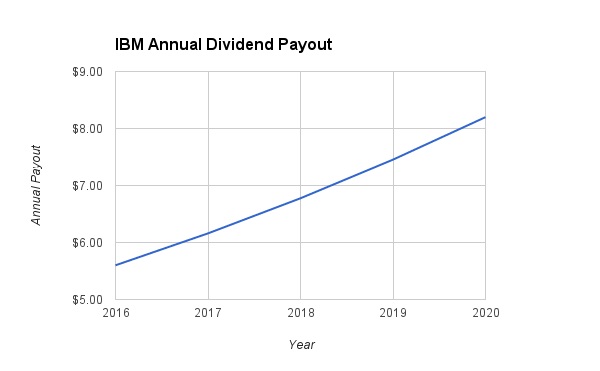It can be difficult to find companies in the technology sector that pay high dividends. Historically, technology firms have been very reluctant to return cash to shareholders, preferring instead to reinvest any excess cash flow back in to the business. To some extent, this makes sense, as the technology industry is intensely competitive and it is vital for companies to invest in future growth and stay on top of the constantly changing landscape.
However, in recent years many tech companies have become so large and highly profitable that they generate more than enough cash flow to sufficiently invest in research and development. Even after internal investment needs, some still have enough cash left over to pay high dividends and raise those dividends regularly.
On April 26, International Business Machines (IBM ) declared a quarterly dividend of $1.40 per share. This compares to the previous quarterly payout of $1.30 per share. The 7.7% dividend increase marks the 21st consecutive year in which IBM has raised dividends. Furthermore, IBM has paid uninterrupted quarterly dividends since 1916. The new annualized dividend rate of $5.60 per share represents a 3.8% yield based on the May 4 closing price. Even so, IBM stock has underperformed in recent periods. Shares are 15% off their 52-week high.

Strong Free Cash Flow Fuels Dividend Growth
IBM is not the same company it used to be. For the first several years of its existence, IBM was a premier technology hardware company. But in recent years, hardware has become less relevant, which has forced IBM into a lengthy turnaround. The company is still struggling and has reported declining revenue for 16 consecutive quarters. Last quarter, total revenue fell 5% year over year, although it was only a 2% decline excluding the effects of currency translations. The strengthening U.S. dollar has eroded revenue for multinational companies like IBM that conduct significant business operations in international markets.
The good news is that IBM’s revenue declines are moderating. In 2015, revenue fell 12% as reported. There is a good chance that IBM’s revenue declines will soon end, and the company will return to revenue growth. The reason why this may happen is that IBM has shifted into higher-value areas like mobile, the cloud, and data. These segments are collectively labeled the “strategic imperatives,” which together represent approximately 37% of IBM’s total revenue. This is an important distinction because these areas are experiencing high growth.
IBM has generated $10.8 billion in cloud revenue over the past 12 months. Cloud revenue soared 42% last quarter and has reached a $5.4 billion annual run rate. Furthermore, mobile revenue soared 93% in constant-currency last quarter, and security-based revenue increased 20% excluding currency, year over year. In all, the strategic imperatives generated $7 billion of revenue last quarter, up 17% year over year after excluding currency translations. This should eventually result in growth to the bottom line—analysts expect IBM to increase earnings per share by 4% next year.
Not only is IBM generating strong growth from new business areas, the process of shifting to higher value has increased free cash flow. In the last 12 months, IBM generated $14 billion of free cash flow. This allows the company to return a great deal of cash to shareholders, which it does through share buybacks and its dividend payments. Its considerable free cash flow covers its dividend sufficiently; IBM’s payout ratio based on expected 2016 earnings per share is 41%. This is a very healthy payout ratio. The company distributes less than half of earnings, which means there is plenty of room for future dividend increases. In addition, IBM has a strong balance sheet. At the end of last quarter, it held $14.8 billion in cash and equivalents on its balance sheet as well as an additional $5.2 billion in long-term marketable investments.
Going forward, investors should expect IBM to continue raising its dividend for many years thanks to its strong cash flow and high-quality balance sheet. Over the past five years, IBM has increased its dividend at a 13% compound annual rate. Its dividend has nearly doubled in that time. However, expectations should be more modest due to the company’s ongoing turnaround. Because the company is still investing heavily to reignite growth, it is unlikely it will be able to raise its dividend at the same rate as its recent averages.
As a result, Dividend.com is forecasting 10% annual dividend growth over the next several years. Under this scenario, IBM’s annual dividend payout will reach $8.20 per share by 2020.

The Bottom Line
Investors may be frustrated with IBM’s lack of progress. On the surface it looks like the turnaround has failed; IBM’s revenue continues to decline quarter after quarter and the stock has underperformed the S&P 500 over the past year. But underneath the surface, the company is doing what it needs to do. It is shifting into higher-value, high-growth businesses, and it continues to increase free cash flow and dividends. Along with its high yield of 3.8%, these qualities make IBM a strong dividend stock pick.





